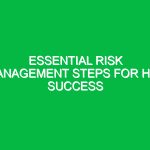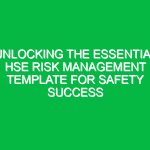Introduction
Hello team! Today, we’re going to hold an important toolbox talk focused on a topic that affects all of us: COVID-19 Cleaning & Decontamination. As we navigate through these challenging times, it’s crucial that we understand the Procedures and Best Practices that help keep our workplace safe and healthy. This talk is designed to equip you with the knowledge you need to maintain a clean Environment and minimize the risk of COVID-19 transmission. Let’s dive in!
The Importance of COVID-19 Cleaning & Decontamination
COVID-19 is primarily spread through respiratory droplets, but it can also survive on surfaces for varying periods. This means that cleaning and disinfecting our workspaces is not just an option; it’s an essential part of our daily routine. Effective COVID-19 Cleaning & Decontamination helps to:
- Reduce transmission risk: By regularly cleaning and disinfecting surfaces, we reduce the likelihood of the virus spreading among employees.
- Promote a safe work environment: A clean workspace contributes to the overall health and wellness of our team.
- Comply with Regulations: Following cleaning protocols helps us meet health and Safety regulations, thereby protecting ourselves and our employers.
Understanding the Cleaning Process
Let’s break down the cleaning process into actionable steps. The key components of COVID-19 Cleaning & Decontamination include:
- Preparation: Before starting, gather all necessary cleaning supplies, including disinfectants approved for COVID-19, gloves, masks, and cleaning cloths.
- Cleaning: Begin by cleaning surfaces with soap and water to remove dirt and impurities. This step is crucial as it ensures that disinfectants work effectively.
- Disinfecting: After cleaning, apply an appropriate disinfectant to surfaces. Ensure that you follow the manufacturer’s instructions regarding contact time, which is how long the surface should remain wet with the disinfectant.
- Final Steps: Once the disinfecting process is complete, allow surfaces to air dry. Make sure to dispose of any cleaning materials properly.
Best Practices for COVID-19 Cleaning & Decontamination
Now that we understand the steps involved, let’s discuss some Best Practices:
- Consistency is Key: Regular cleaning schedules should be established. High-touch areas such as doorknobs, light switches, and communal equipment require more frequent cleaning.
- Use the Right Products: Always use EPA-approved disinfectants for COVID-19. Check labels to ensure they meet the necessary criteria.
- Educate and Train: Ensure all employees are trained on proper cleaning techniques and understand the importance of their role in maintaining a safe workplace.
- Communicate: If you notice a surface that needs cleaning during your shift, report it immediately. Teamwork is essential in maintaining cleanliness.
Potential Hazards and Risks
While cleaning and disinfecting can significantly reduce the risk of COVID-19, there are some potential Hazards to be aware of:
- Chemical Exposure: Some cleaning chemicals can cause irritation or allergic reactions. Always read labels and use the products as directed.
- Physical Hazards: Be mindful of your environment while cleaning. Ensure that you do not create slip hazards with wet floors.
- Inadequate Ventilation: Ensure that areas are well-ventilated when using cleaning products to minimize inhalation risks.
Real-Life Scenarios
Let’s think about a couple of scenarios you might face:
- Scenario 1: Imagine you’re in the break room, and you notice that the tables haven’t been cleaned after lunchtime. What should you do? First, report it to your supervisor, and if you can, clean the area before you sit down.
- Scenario 2: You’re cleaning a shared piece of equipment, such as a printer. What’s your process? First, wear gloves and a mask, clean the surfaces with soap and water, and then apply disinfectant, ensuring you follow the contact time.
Regulations and Standards
It’s vital to be aware of the regulations surrounding COVID-19 Cleaning & Decontamination. The Centers for Disease Control and Prevention (CDC) and the Occupational Safety and Health Administration (OSHA) provide guidelines that we must follow. Compliance not only keeps us safe but also protects our organization from potential legal issues.
Conclusion
In closing, the importance of COVID-19 Cleaning & Decontamination cannot be overstated. Each one of you plays a critical role in keeping our workplace safe. I encourage you to take these practices seriously and to integrate them into your daily routines. Thank you all for your attention and your commitment to maintaining a safe environment. Together, we can make a significant impact in preventing the spread of COVID-19.


